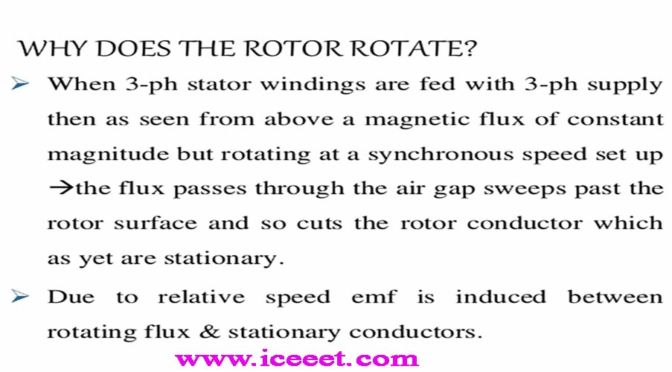An induction motor also known as an asynchronous motor is a generally used AC electric motor. For an induction motor, the electrical current or AC in the rotor needed to produce torque is gain through electromagnetic induction from the rotating magnetic field of the stator winding. The rotor of an induction motor can be used as a squirrel cage rotor.
Table of Contents
Why Does The Rotor Rotate
When the three-phase power supply to the stator. This current flows to the stator winding(conductor). Then it produces magnetic flux and it’s rotated to the clockwise direction around the conductor. Magnetic flux induced to the rotor bar by the electromagnetic induction law. For this flux rotor received magnetomotive forces and the rotor build up rotating torque.
Finally, the rotor rotates a similar direction to magnetic flux.
why the induction motor is called an induction motor?
An induction motor has a two-part Stator and Rotor. No magnetic and electric connection between them. Electric flux induced to the rotor by the Faraday’s law electromagnetic induction. For that, the induction motor is called the induction motor.
Best Article of SPEED CONTROL OF DC MOTOR (SHUNT, SERIES, AND COMPOUND)
Related Link:
Compare Business Electricity Prices | Rates | Supplier Quotes | Saving Tips
Electrical Circuit Breaker | Operation and Types of Circuit Breaker
What Is a Fuse? Types of Fuses And Its Application.
How To Work Horn Antenna | Practical Application | Advantage & Disadvantage
Different Types Of Antennas With Properties | Their Working
What is Rectifier? Explain Different Types of Rectifiers
Semiconductor Diode/Types of Diode/And Their Application
Wye Delta Transformation Conversion
Owner Of ICEEET





10 comments
[…] By Habib Alternators Machine July 13, […]
[…] By Habib DC Motor Machine September 27, […]
[…] with lower total harmonic distortion. This method overcomes the old technic SPWM to control an AC motor that has high-harmonic distortion due to the asymmetrical nature of the PWM switching […]
[…] INDUCTION MOTOR | WHY DOES THE ROTOR ROTATE | WORKING PRINCIPLE […]
[…] INDUCTION MOTOR | WHY DOES THE ROTOR ROTATE | WORKING PRINCIPLE […]
[…] INDUCTION MOTOR | WHY DOES THE ROTOR ROTATE | WORKING PRINCIPLE […]
[…] INDUCTION MOTOR | WHY DOES THE ROTOR ROTATE | WORKING PRINCIPLE […]
[…] INDUCTION MOTOR | WHY DOES THE ROTOR ROTATE | WORKING PRINCIPLE […]
[…] principle of feedback is possibly as old as the invention of the first machine but it is only some 50 years ago that feedback has come into use in connection with electronic […]
[…] through magnets and coils of copper wires in big power plants. Based on this principle, both the electric motor (where electricity is converted into motion) and the generator (where motion is converted into […]